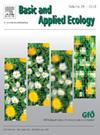Farmland bird decline is associated with a strong population limitation of open-habitat species
IF 3.5
2区 环境科学与生态学
Q2 ECOLOGY
引用次数: 0
Abstract
Farmland birds rank among organisms showing the steepest declines of their European populations. To combat these declines, it is essential to understand demographic mechanisms underlying the negative population trends. For this purpose, we employ a novel modelling approach on a long-term multispecies dataset collected by citizen scientists throughout Czechia. Using this approach, we calculated recruitment, adult survival and population growth rates for 13 farmland bird species on annual basis from 2004 to 2021, and related these demographic rates to species population trends estimated over the same period, as well as to their habitat preferences. We observed a negative relationship between recruitment and adult survival within most species. This relationship becomes increasingly more negative in species breeding in more open habitats. These species also showed steeper population declines and less positive correlation between adult survival and population growth rate than species breeding more woody habitats. These results indicate that the open-habitat farmland birds face strong population regulation. Under such regulation, higher adult survival in some years, that may occur due to, for instance, suitable weather conditions, does not leave much capacity for new recruits, and thus is immediately compensated by low recruitment. We suggest that these demographic processes are underpinned by decreasing carrying capacity of the open habitats which may occur due to shrub encroachment or afforestation of agricultural land that are widespread in Europe. At the same time, species preferring woody habitats enjoy increasing habitat availability in farmland which may lead to population increases over the long-term. Our results indicate that conservation actions are needed to improve the carrying capacity of the open habitats, especially during the breeding season. For example, some initiatives aiming for mitigation of climate change impacts by afforestation should be carefully reconsidered to avoid adverse impacts on open habitat species.
农田鸟类的减少与开放生境物种的数量限制有关
农田鸟类是欧洲种群数量下降最快的生物之一。为了应对这些下降,有必要了解人口负趋势背后的人口机制。为此,我们采用了一种新的建模方法,对捷克公民科学家收集的长期多物种数据集进行建模。利用该方法,我们计算了2004 - 2021年13种农田鸟类的年度招募率、成虫存活率和种群增长率,并将这些人口统计率与同期估计的物种种群趋势及其栖息地偏好联系起来。我们观察到,在大多数物种中,招募与成虫存活率呈负相关。在更开放的栖息地繁殖的物种中,这种关系变得越来越消极。这些物种的种群数量下降幅度更大,成虫存活率与种群增长率之间的正相关关系也更弱。这些结果表明,露天生境农田鸟类的种群数量受到很强的调控。在这种规定下,在某些年份,由于例如天气条件适宜而可能出现的较高的成人存活率,并没有为新兵留下多少能力,因此立即以低征聘来补偿。我们认为,这些人口统计过程的基础是,由于欧洲普遍存在的灌木侵占或农业用地造林,开放生境的承载能力可能会下降。与此同时,喜欢木质栖息地的物种在农田中享有越来越多的栖息地,这可能导致长期的种群增长。我们的研究结果表明,需要采取保护措施来提高开放生境的承载能力,特别是在繁殖季节。例如,应仔细重新考虑旨在通过植树造林减轻气候变化影响的一些举措,以避免对开放生境物种产生不利影响。
本文章由计算机程序翻译,如有差异,请以英文原文为准。
求助全文
约1分钟内获得全文
求助全文
来源期刊

Basic and Applied Ecology
环境科学-生态学
CiteScore
6.90
自引率
5.30%
发文量
103
审稿时长
10.6 weeks
期刊介绍:
Basic and Applied Ecology provides a forum in which significant advances and ideas can be rapidly communicated to a wide audience. Basic and Applied Ecology publishes original contributions, perspectives and reviews from all areas of basic and applied ecology. Ecologists from all countries are invited to publish ecological research of international interest in its pages. There is no bias with regard to taxon or geographical area.
 求助内容:
求助内容: 应助结果提醒方式:
应助结果提醒方式:


